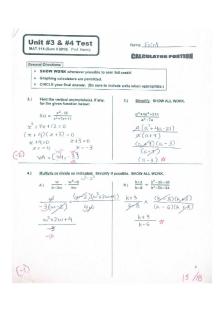Biology Unit 3 Test with answers given PDF

| Title | Biology Unit 3 Test with answers given |
|---|---|
| Course | Introduction To Biology |
| Institution | South Georgia State College |
| Pages | 1 |
| File Size | 44.9 KB |
| File Type | |
| Total Downloads | 57 |
| Total Views | 148 |
Summary
This is the answers and questions to the unit three biology test for SGSC. Hope this helps....
Description
Unit 3 Test 1. Which structure consists of a framework of different proteins that work together to provide a scaffold for the cell? Cytoskeleton 2. Which cell structure appears as a single large sphere in the cell? Nucleus 3. Which macromolecule would be found in the large structure described in the question above? DNA 4. Which structure is composed of a set of membranous folds and is involved in exporting proteins produced by the cell? Golgi 5. What structure allows a sperm cell to move? Flagella 6. Which cell structure is involved in protein and lipid synthesis? Endoplasmic Reticulum 7. Which cell structures are involved in converting sugar to ATP? Mitochondria 8. A scientist has used a staining dye to observe multiple cells. Not all cells were stained. The stained cells were smaller and contained circular DNA. The unstained cells were larger and contained linear DNA. What kind of cell is stained here? Prokaryotic 9. How do the stained and unstained cells differ? The stained cell does not have complex organelles 10. Another stain is used to investigate a plant protein. It is found that the protein is localized to the chloroplast. What is a reasonable hypothesis for the function of this protein? This protein could be used in photosynthesis. 11. One of the ways that stains work is by being transported across the cell membrane into the cell. If a stain molecule is large and polar, which type of membrane transport is likely used to move it into the cell? Facilitated diffusion 12. A stain can also work by attaching to the cell membrane itself. If a stain attaches to the hydrophobic portion of the cell membrane, which part of the cell membrane will be stained? The inner layer 13. How does the cell membrane work to maintain homeostasis? It allows certain molecules in and out depending on the needs of the cell. 14. Some stains can bond with the components of cell walls. How could these stains be used? To distinguish between animal and plant cells...
Similar Free PDFs

Unit 3 test - test answers
- 8 Pages

Biology Quiz with answers
- 18 Pages

Biology 11 Unit 1 Answers
- 29 Pages

Biology Unit Test - Digestive System
- 13 Pages

Biology 101 Unit 3 GRQs
- 25 Pages

Unit-3 Biology Discussion Forum
- 3 Pages

Biology UNIT 3-4 Notesssssd
- 63 Pages

Tutorial 3 - with answers
- 8 Pages

Tutorial 3 - (with Answers)
- 4 Pages

Unit 3 study guide - unit test 3
- 3 Pages

Astronomy - Unit 3 Test - Unit 3
- 8 Pages
Popular Institutions
- Tinajero National High School - Annex
- Politeknik Caltex Riau
- Yokohama City University
- SGT University
- University of Al-Qadisiyah
- Divine Word College of Vigan
- Techniek College Rotterdam
- Universidade de Santiago
- Universiti Teknologi MARA Cawangan Johor Kampus Pasir Gudang
- Poltekkes Kemenkes Yogyakarta
- Baguio City National High School
- Colegio san marcos
- preparatoria uno
- Centro de Bachillerato Tecnológico Industrial y de Servicios No. 107
- Dalian Maritime University
- Quang Trung Secondary School
- Colegio Tecnológico en Informática
- Corporación Regional de Educación Superior
- Grupo CEDVA
- Dar Al Uloom University
- Centro de Estudios Preuniversitarios de la Universidad Nacional de Ingeniería
- 上智大学
- Aakash International School, Nuna Majara
- San Felipe Neri Catholic School
- Kang Chiao International School - New Taipei City
- Misamis Occidental National High School
- Institución Educativa Escuela Normal Juan Ladrilleros
- Kolehiyo ng Pantukan
- Batanes State College
- Instituto Continental
- Sekolah Menengah Kejuruan Kesehatan Kaltara (Tarakan)
- Colegio de La Inmaculada Concepcion - Cebu




